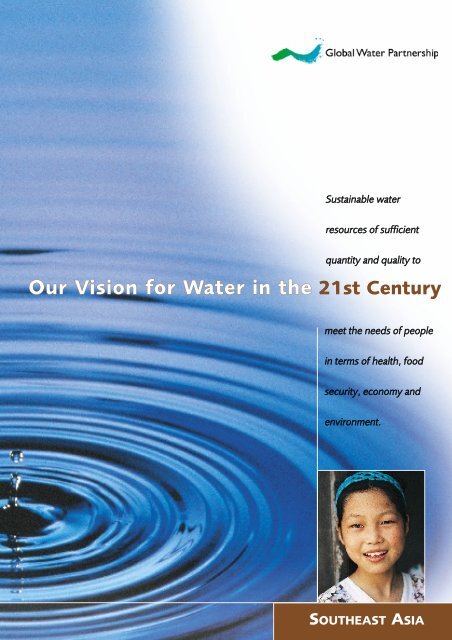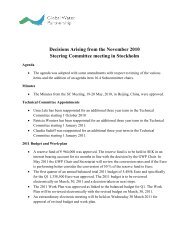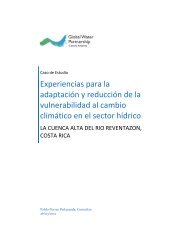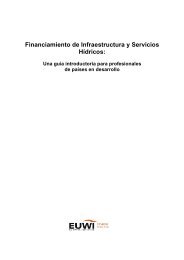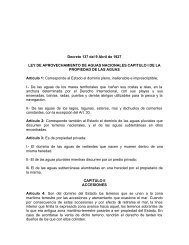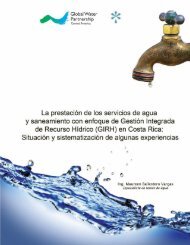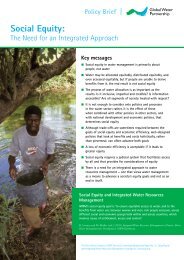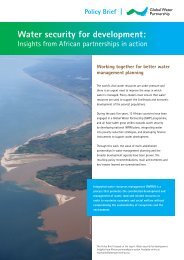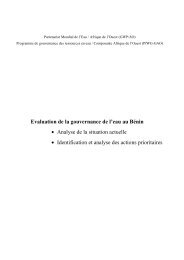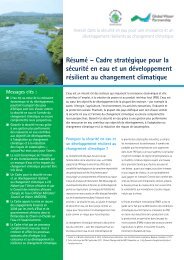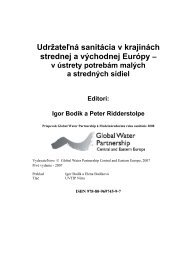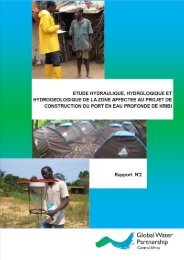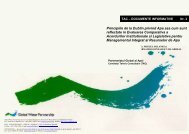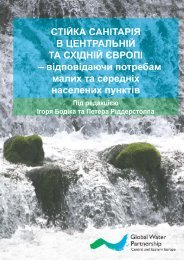Our Vision for Water in the 21st Century - Global Water Partnership
Our Vision for Water in the 21st Century - Global Water Partnership
Our Vision for Water in the 21st Century - Global Water Partnership
Create successful ePaper yourself
Turn your PDF publications into a flip-book with our unique Google optimized e-Paper software.
Susta<strong>in</strong>able water<br />
resources of sufficient<br />
quantity and quality to<br />
<strong>Our</strong> <strong>Vision</strong> <strong>for</strong> <strong>Water</strong> <strong>in</strong> <strong>the</strong> <strong>21st</strong> <strong>Century</strong><br />
meet <strong>the</strong> needs of people<br />
<strong>in</strong> terms of health, food<br />
security, economy and<br />
environment.<br />
SOUTHEAST ASIA
SOUTHEAST ASIA<br />
<strong>Water</strong> <strong>for</strong> <strong>the</strong> <strong>21st</strong> <strong>Century</strong>: <strong>Vision</strong> to Action<br />
SUMMARY<br />
<strong>Water</strong> is a fundamental natural resource and <strong>the</strong>re has been grow<strong>in</strong>g<br />
recognition that its use and management must be improved if a water<br />
crisis is to be avoided. The role of water <strong>in</strong> contribut<strong>in</strong>g to alleviat<strong>in</strong>g<br />
poverty, underp<strong>in</strong>n<strong>in</strong>g secure livelihoods, streng<strong>the</strong>n<strong>in</strong>g economies and<br />
susta<strong>in</strong><strong>in</strong>g environmental and ecological systems is central to all development<br />
goals.<br />
To help def<strong>in</strong>e <strong>the</strong> actions needed to improve <strong>the</strong> management of<br />
water <strong>in</strong> Sou<strong>the</strong>ast Asia, <strong>the</strong> document, <strong>Water</strong> <strong>for</strong> <strong>the</strong> <strong>21st</strong> <strong>Century</strong>:<br />
<strong>Vision</strong> to Action — Sou<strong>the</strong>ast Asia, was prepared <strong>for</strong> presentation at<br />
<strong>the</strong> Second World <strong>Water</strong> Forum and M<strong>in</strong>isterial Conference at The<br />
Hague, <strong>the</strong> Ne<strong>the</strong>rlands March 17-22, 2000.<br />
Sou<strong>the</strong>ast Asia’s <strong>Vision</strong> <strong>for</strong> <strong>Water</strong> <strong>for</strong> <strong>the</strong> <strong>21st</strong> <strong>Century</strong><br />
The <strong>Vision</strong> of Sou<strong>the</strong>ast Asia <strong>for</strong> water <strong>in</strong> <strong>the</strong> new century is: <strong>the</strong> atta<strong>in</strong>ment<br />
of susta<strong>in</strong>ability of water resources to ensure sufficient water<br />
quantity of acceptable quality to meet <strong>the</strong> needs of <strong>the</strong> people of<br />
Sou<strong>the</strong>ast Asia <strong>in</strong> terms of health, food security, economy, and environment.<br />
This vision means:<br />
Access to safe, adequate and af<strong>for</strong>dable water supply, hygiene, and<br />
sanitation.<br />
Provision of sufficient water that will ensure food security <strong>for</strong> <strong>the</strong><br />
region.<br />
Provision of sufficient water to spur and susta<strong>in</strong> <strong>the</strong> economies of <strong>the</strong><br />
region.<br />
Protection of <strong>the</strong> water environment to preserve flow regimes, biodiversity<br />
and cultural heritage as well as <strong>the</strong> mitigation of water related<br />
hazards.<br />
BACKGROUND<br />
<strong>Water</strong> resources and uses <strong>in</strong> Sou<strong>the</strong>ast Asia<br />
Compared to previous eras, <strong>the</strong> last half of <strong>the</strong> 20th <strong>Century</strong> was characterised<br />
by unprecedented changes and irreversible trends <strong>in</strong> natural,<br />
technological, social, economic, and political factors that have affected<br />
human life <strong>in</strong> radical ways. Comb<strong>in</strong>ed with population growth, urbanisation,<br />
<strong>in</strong>dustrialisation and economic development, this has exerted<br />
high pressure and demand on natural resources, most notably on water<br />
resources.<br />
Increas<strong>in</strong>g conflicts among compet<strong>in</strong>g uses <strong>for</strong> water such as dr<strong>in</strong>k<strong>in</strong>g<br />
water supply, irrigation, hydropower, and <strong>in</strong>dustry are a result of <strong>the</strong><br />
press<strong>in</strong>g needs <strong>for</strong> social and economic welfare and development.<br />
Industrialisation and <strong>the</strong> grow<strong>in</strong>g population have resulted <strong>in</strong> <strong>in</strong>creas<strong>in</strong>g<br />
<strong>the</strong> undesirable levels of water quality and quantity. Unless society
is able to develop and apply solutions to <strong>the</strong>se problems <strong>the</strong>n human<br />
life, health and well-be<strong>in</strong>g are <strong>in</strong> peril.<br />
Land and water resources availability<br />
The total land area of <strong>the</strong> Sou<strong>the</strong>ast Asia exceeds 435 million hectares<br />
or 4,350,000 square kilometres. The geography of <strong>the</strong> region <strong>in</strong>cludes<br />
small compact states, <strong>the</strong> archipelagos, <strong>the</strong> pen<strong>in</strong>sular nations to <strong>the</strong><br />
ma<strong>in</strong>land nations with shared <strong>in</strong>land borders and coastal boundaries.<br />
The climate is generally humid tropical, <strong>the</strong> region be<strong>in</strong>g blessed with<br />
abundant ra<strong>in</strong>fall which ranges from 1600 to 3000 millimetres per year.<br />
The humid climate yields an average total water resources availability<br />
<strong>for</strong> <strong>the</strong> region that exceeds 5500 cubic kilometres per year, present <strong>in</strong><br />
both surface water and groundwater reserves.<br />
Population factors and water uses and services<br />
By <strong>the</strong> end of <strong>the</strong> 20th <strong>Century</strong> <strong>the</strong> total population of <strong>the</strong> region<br />
exceeded 550 million. This is expected to rise by around 50%, or by an<br />
additional 250 million, by 2025. This translates to around 50% rise <strong>in</strong> <strong>the</strong><br />
population density per country, and <strong>the</strong> average population density of<br />
<strong>the</strong> region will rise from 1.3 persons per hectare to 2.0 persons per<br />
hectare. By 2025, per capita natural water availability will drop from 10<br />
to 6.7 thousand cubic meters per year. In daily per capita values, freshwater<br />
availability will decrease from 27 to 18 cubic meters per person<br />
per day.<br />
More than 70% of water use <strong>in</strong> <strong>the</strong> region is devoted to agricultural purposes<br />
or irrigation of staple crops, ma<strong>in</strong>ly rice. Domestic and municipal<br />
water use ranges from 10-20% of total water use, while water <strong>for</strong> <strong>in</strong>dustrial<br />
use is about 10% or less of total use. The extent of <strong>the</strong> population<br />
with access to safe water is generally below 50% <strong>for</strong> rural populations<br />
but above 50% <strong>for</strong> urban populations. The present total <strong>in</strong>stalled<br />
hydropower capacity is less than 5% of potential capacity while less<br />
than 50%of <strong>the</strong> total flood-prone area of <strong>the</strong> lowland areas is provided<br />
with flood control protection measures.<br />
Objectives of <strong>the</strong> <strong>Vision</strong> and Framework <strong>for</strong> Action<br />
The long-term vision <strong>for</strong> <strong>the</strong> region that clearly depicts <strong>the</strong> a desirable<br />
water world <strong>in</strong> <strong>the</strong> year 2025, and a strategy and framework <strong>for</strong> action<br />
to achieve this vision, was coord<strong>in</strong>ated by <strong>the</strong> Sou<strong>the</strong>ast Asia Technical<br />
Advisory Committee (SEATAC) of <strong>the</strong> <strong>Global</strong> <strong>Water</strong> <strong>Partnership</strong> (GWP).<br />
Consultations <strong>in</strong>cluded stakeholders from Brunei Darussalam,<br />
Cambodia, Indonesia, Lao PDR, Malaysia, Myanmar, Philipp<strong>in</strong>es,<br />
S<strong>in</strong>gapore, Thailand and Vietnam.<br />
The regional vision aims to spur all regional water stakeholders to <strong>for</strong>m<br />
and build a consensus on <strong>the</strong> state of water resources <strong>in</strong> <strong>the</strong> region <strong>for</strong><br />
<strong>the</strong> year 2025. The framework presented below <strong>in</strong>cludes <strong>the</strong> challenges,<br />
<strong>the</strong> implementation strategies and <strong>the</strong> actions required to achieve <strong>the</strong><br />
vision.<br />
SOUTHEAST ASIA’S FRAMEWORK FOR ACTION<br />
Sou<strong>the</strong>ast Asia’s framework <strong>for</strong> action <strong>for</strong> a better water future is <strong>for</strong>mulated<br />
to meet <strong>the</strong> <strong>for</strong>emost challenges fac<strong>in</strong>g <strong>the</strong> region which are:<br />
manag<strong>in</strong>g our water resources efficiently and effectively
mov<strong>in</strong>g towards <strong>in</strong>tegrated river bas<strong>in</strong> management<br />
translat<strong>in</strong>g awareness to political will and capacities<br />
mov<strong>in</strong>g towards adequate and af<strong>for</strong>dable water services.<br />
Manag<strong>in</strong>g our water resources efficiently and effectively<br />
Like <strong>the</strong> rest of <strong>the</strong> world, Sou<strong>the</strong>ast Asia is faced with a grow<strong>in</strong>g population<br />
that is expected to <strong>in</strong>crease by a fur<strong>the</strong>r 50% by 2025. Rural to<br />
urban migration is evident with a relatively large proportion of <strong>the</strong> population<br />
concentrated <strong>in</strong> cities where high economic activities exist. With<br />
<strong>the</strong> growth <strong>in</strong> population, <strong>in</strong>creas<strong>in</strong>g economic development and<br />
improvements <strong>in</strong> <strong>the</strong> standards of liv<strong>in</strong>g, demands <strong>for</strong> water has<br />
<strong>in</strong>creased. Ris<strong>in</strong>g pollution due to a lack of wastewater disposal, sanitation<br />
and proper solid waste management is fur<strong>the</strong>r reduc<strong>in</strong>g <strong>the</strong> availability<br />
of our water supplies. To reverse this degradation of our land and<br />
water resources we need to have more efficient and effective management<br />
of our water resources. To achieve this, we have to undertake <strong>the</strong><br />
follow<strong>in</strong>g actions:<br />
Review of policy and legislation<br />
Fragmentation of responsibilities <strong>for</strong> water resources management<br />
with<strong>in</strong> governments is common result<strong>in</strong>g <strong>in</strong> overlapp<strong>in</strong>g of functions<br />
and fragmented as well as conflict<strong>in</strong>g policies. Too many government<br />
agencies are <strong>in</strong>volved <strong>in</strong> <strong>the</strong> different aspects of water management:<br />
irrigation, domestic and <strong>in</strong>dustrial supply, flood control, and <strong>in</strong>frastructure<br />
development among o<strong>the</strong>rs. Clearly, <strong>the</strong> traditional approach of<br />
develop<strong>in</strong>g water resources by sectors is no longer appropriate. The<br />
<strong>in</strong>ter-relationship between land and water should be <strong>in</strong>cluded <strong>in</strong> <strong>the</strong><br />
plann<strong>in</strong>g process. The adoption of <strong>in</strong>tegrated water resources management<br />
(IWRM) is <strong>the</strong>re<strong>for</strong>e critical.<br />
Fur<strong>the</strong>rmore, <strong>the</strong> common perception that water be<strong>in</strong>g a basic human<br />
need should be provided “free” has resulted <strong>in</strong> very low tariffs which<br />
cannot support ma<strong>in</strong>tenance and expansion requirements. Competition<br />
among users is also common. The <strong>in</strong>troduction of cost recovery policies,<br />
economic valuation of water, and <strong>the</strong> “polluter pays” pr<strong>in</strong>ciple is necessary<br />
to ensure <strong>the</strong> availability of good quality water <strong>for</strong> all.<br />
Institute demand and supply management techniques<br />
The use of demand management techniques should be encouraged.<br />
Already, a number of water-sav<strong>in</strong>g technologies exist <strong>in</strong> <strong>the</strong> market<br />
today i.e. slow-flow showers, two-piped systems, half-flush toilets,<br />
among o<strong>the</strong>rs. Governments should provide <strong>in</strong>centives <strong>for</strong> its use<br />
through lower taxes or ‘tax holidays’ to reduce costs.<br />
Given that Sou<strong>the</strong>ast Asia is primarily a rice-produc<strong>in</strong>g region, <strong>the</strong> agricultural<br />
sector commands <strong>the</strong> highest demand <strong>for</strong> water resources, over<br />
70%. As such, <strong>the</strong>re is a potential <strong>for</strong> significant water “sav<strong>in</strong>gs” by<br />
employ<strong>in</strong>g water-conservation technologies such as farm level water<br />
management — drip-gravity irrigation — soil moisture conservation<br />
measures and cropp<strong>in</strong>g management techniques. Where appropriate
and af<strong>for</strong>dable, water-sav<strong>in</strong>g technologies that already exist <strong>for</strong> ei<strong>the</strong>r<br />
irrigation and domestic supply should be encouraged.<br />
Moreover, <strong>the</strong> <strong>in</strong>troduction of <strong>in</strong>tra-country and more importantly<br />
regional cooperation <strong>in</strong> shared river bas<strong>in</strong>s will result <strong>in</strong> a more efficient<br />
management of water supply.<br />
Undertake research and development programmes<br />
Research and development activities on a range of activities — water<br />
conservation, water quality management, pollution control, water recovery,<br />
re-use and recycl<strong>in</strong>g, watershed, flood-pla<strong>in</strong> and coastal management,<br />
and water-data network design and implementation — must be<br />
undertaken to ensure a more effective management our water<br />
resources system.<br />
Mov<strong>in</strong>g towards <strong>in</strong>tegrated river bas<strong>in</strong> management<br />
A river bas<strong>in</strong> is a geographical unit with a well-def<strong>in</strong>ed boundary that<br />
encompasses <strong>the</strong> totality of <strong>the</strong> hydrological process which transcends<br />
political and adm<strong>in</strong>istrative limits. It is <strong>the</strong> ideal management unit<br />
<strong>the</strong>re<strong>for</strong>e, to address water-related problems so it is necessary to:<br />
Establish river bas<strong>in</strong> management organisations<br />
An <strong>in</strong>tegrated river bas<strong>in</strong> management organisation should be established<br />
<strong>in</strong> each selected local and <strong>in</strong>ternational bas<strong>in</strong> <strong>in</strong> our region.<br />
Develop decision support systems<br />
The collection, management, and dissem<strong>in</strong>ation of bas<strong>in</strong>-wide data on<br />
land and water resources, <strong>the</strong>ir allocation and multiple uses, are important<br />
basic functions of <strong>the</strong> <strong>in</strong>tegrated river bas<strong>in</strong> management. In addition<br />
to provid<strong>in</strong>g vital public <strong>in</strong><strong>for</strong>mation on natural resources, <strong>the</strong> data<br />
will serve as quantitative <strong>in</strong>puts to decision support systems that management<br />
utilises <strong>for</strong> decision-mak<strong>in</strong>g on plann<strong>in</strong>g, design, implementation,<br />
and operations of water-resources and o<strong>the</strong>r bas<strong>in</strong>-development<br />
programmes and projects.<br />
Promote equitable shar<strong>in</strong>g among water users and environment<br />
The river bas<strong>in</strong> is also <strong>the</strong> ideal venue to promote equitable shar<strong>in</strong>g<br />
among conflict<strong>in</strong>g water users and <strong>the</strong> environment, because <strong>the</strong> various<br />
users — water supply, irrigation, flood control, hydropower, environment<br />
— must share water with<strong>in</strong> <strong>the</strong> same river bas<strong>in</strong>.<br />
Mitigate water-related hazards and ma<strong>in</strong>ta<strong>in</strong> ecological<br />
balance<br />
In addition to water utilisation, <strong>the</strong> river bas<strong>in</strong> management organisation<br />
should lead <strong>in</strong> <strong>the</strong> mitigation of water-related hazards such as<br />
floods, droughts, and erosion, while ma<strong>in</strong>ta<strong>in</strong><strong>in</strong>g <strong>the</strong> ecological balance.<br />
Translat<strong>in</strong>g awareness to political will and capacities<br />
Sou<strong>the</strong>ast Asia is blessed with one of <strong>the</strong> highest renewable freshwater<br />
resource. Consequently, <strong>the</strong> water problems besett<strong>in</strong>g our region perta<strong>in</strong><br />
more to issues of delivery than to supply. To a large extent, <strong>the</strong>
issue is exacerbated by <strong>the</strong> existence of weak sector leadership and <strong>the</strong><br />
absence of political will to implement <strong>the</strong> much needed re<strong>for</strong>ms <strong>in</strong> <strong>the</strong><br />
water sector. There is <strong>the</strong>re<strong>for</strong>e, a need to <strong>in</strong>still awareness on <strong>the</strong> economic,<br />
social and environmental value of water among politicians, decision-makers<br />
and o<strong>the</strong>r stakeholders <strong>in</strong> <strong>the</strong> water sector. Achievement of<br />
political will and build<strong>in</strong>g of capacities play a vital role <strong>in</strong> <strong>the</strong> atta<strong>in</strong>ment<br />
of susta<strong>in</strong>able water resources development and management. In<br />
our region we must:<br />
Improve governance<br />
Government should take <strong>the</strong> lead <strong>in</strong> ensur<strong>in</strong>g susta<strong>in</strong>able water management<br />
with <strong>the</strong> active participation of all stakeholders. Good governance<br />
requires an <strong>in</strong>stitution where committed leadership and empowered<br />
constituency exist. Government, <strong>the</strong> private sector and <strong>the</strong> community<br />
should work toge<strong>the</strong>r to ensure that all water-related concerns<br />
and <strong>in</strong>terests are addressed.<br />
Encourage multiple stakeholder participation <strong>in</strong> water<br />
resources development and management<br />
The development of a well-<strong>in</strong><strong>for</strong>med and motivated society equipped<br />
with <strong>the</strong> understand<strong>in</strong>g and appreciation of <strong>the</strong> complex nature of<br />
water resources management is an important element towards achiev<strong>in</strong>g<br />
efficient and effective water management. Accord<strong>in</strong>gly, <strong>the</strong> core<br />
issue today evolves around people’s participation, with special focus on<br />
<strong>the</strong> poor, women and children who are most affected by <strong>the</strong> problems<br />
of water shortages, pollution and floods. Thus, it has become necessary<br />
to create social awareness and promote public participation through<br />
mass-based <strong>in</strong><strong>for</strong>mation, education and communication campaigns,<br />
and water-related curricula should be <strong>in</strong>corporation at all levels <strong>in</strong> both<br />
<strong>for</strong>mal and non-<strong>for</strong>mal education.<br />
Develop, enhance and streng<strong>the</strong>n <strong>in</strong>stitutions on a decentralised<br />
and participatory manner<br />
The <strong>in</strong>tegrated water resources management paradigm requires <strong>the</strong><br />
development and/or streng<strong>the</strong>n<strong>in</strong>g of water-related <strong>in</strong>stitutions on a<br />
decentralised basis with support from well-<strong>in</strong><strong>for</strong>med stakeholders.<br />
Susta<strong>in</strong>able water management from a decentralised local perspective<br />
is expected to result <strong>in</strong> improved water access and delivery of services<br />
<strong>for</strong> all concerned. Such decentralisation will mean improv<strong>in</strong>g <strong>the</strong> capacity<br />
of local <strong>in</strong>stitutions <strong>in</strong> <strong>the</strong> field of <strong>in</strong>tegrated water resources development<br />
and management.<br />
Build <strong>in</strong>dividual capacities<br />
Empowerment and capacity build<strong>in</strong>g are essential elements <strong>in</strong> pursu<strong>in</strong>g<br />
effective water sector governance. The empowerment of water sector<br />
stakeholders requires <strong>the</strong> build<strong>in</strong>g of <strong>in</strong>dividual capacities though <strong>the</strong><br />
conduct of broad-based tra<strong>in</strong><strong>in</strong>g programmes on <strong>in</strong>tegrated water<br />
resources development and management. Human resources development<br />
ef<strong>for</strong>ts must be undertaken to create a pool of sufficiently tra<strong>in</strong>ed<br />
and skilled persons.<br />
Mov<strong>in</strong>g towards adequate and af<strong>for</strong>dable water services<br />
Inadequate <strong>in</strong>frastructure, <strong>the</strong> absence of clear policies <strong>for</strong> public-pri-
vate partnerships, and <strong>the</strong> practice of government subsidies have<br />
impacted negatively on <strong>the</strong> water sector <strong>in</strong> a number of countries <strong>in</strong> <strong>the</strong><br />
region. In general, exist<strong>in</strong>g water distribution systems <strong>for</strong> domestic use<br />
and irrigation are largely <strong>in</strong>efficient and fast deteriorat<strong>in</strong>g as a result of<br />
low tariffs. Given <strong>the</strong> capital requirements <strong>for</strong> expansion and ma<strong>in</strong>tenance<br />
of <strong>the</strong>se systems, governments are f<strong>in</strong>d<strong>in</strong>g it more and more difficult<br />
to meet <strong>the</strong> water requirements of a grow<strong>in</strong>g population <strong>for</strong><br />
domestic and <strong>in</strong>dustrial use, and <strong>for</strong> food security. Public-private partnerships<br />
are <strong>the</strong>re<strong>for</strong>e encouraged to fill this gap.<br />
Enhance public-private partnerships<br />
There is a need <strong>for</strong> clear and consistent policies to encourage private<br />
sector participation <strong>in</strong> <strong>the</strong> water sector. Often, chang<strong>in</strong>g rules erodes<br />
<strong>in</strong>vestor confidence. The implementation of a clear and transparent<br />
process <strong>in</strong> <strong>the</strong> bidd<strong>in</strong>g of projects will attract private <strong>in</strong>vestments.<br />
Moreover, <strong>the</strong>re is a limited understand<strong>in</strong>g of public-private partnerships.<br />
The options are varied and choices will depend on <strong>the</strong> <strong>in</strong>dividual<br />
circumstances of each case. The first step is know<strong>in</strong>g what <strong>the</strong> available<br />
options are.<br />
Recognise that water is an economic good<br />
In most parts of <strong>the</strong> region, water is still regarded as “free”, with governments<br />
subsidis<strong>in</strong>g <strong>the</strong> delivery of <strong>the</strong> services. This has resulted <strong>in</strong> <strong>the</strong><br />
deterioration of <strong>the</strong> system and <strong>the</strong> eventual breakdown <strong>in</strong> <strong>the</strong> delivery<br />
of <strong>the</strong> services. In such cases, <strong>the</strong> poor actually pay more <strong>for</strong> water than<br />
<strong>the</strong> rich s<strong>in</strong>ce <strong>the</strong> <strong>for</strong>mer have no choice but to buy water from water<br />
vendors. The imposition of tariffs that reflect cost recovery pr<strong>in</strong>ciples<br />
and <strong>the</strong> recognition that water is an economic good will, <strong>in</strong> <strong>the</strong> longrun,<br />
result <strong>in</strong> a more efficient system.<br />
<strong>Vision</strong> to Action<br />
<strong>Water</strong> is widely mismanaged and unless we change our ways of manag<strong>in</strong>g<br />
this resource, we will face a serious crisis <strong>in</strong> <strong>the</strong> near future. The<br />
actions detailed above to redress this situation <strong>in</strong> Sou<strong>the</strong>ast Asia are<br />
derived from <strong>the</strong> document, <strong>Water</strong> <strong>for</strong> <strong>the</strong> <strong>21st</strong> <strong>Century</strong>: <strong>Vision</strong> to Action<br />
– Sou<strong>the</strong>ast Asia,which was prepared <strong>for</strong> presentation at <strong>the</strong> Second<br />
World <strong>Water</strong> Forum and M<strong>in</strong>isterial Conference at The Hague, <strong>the</strong><br />
Ne<strong>the</strong>rlands, March17-22, 2000. The consultations result<strong>in</strong>g <strong>in</strong> this document<br />
were coord<strong>in</strong>ated by <strong>the</strong> Sou<strong>the</strong>ast Asia Technical Advisory<br />
Committee of <strong>the</strong> <strong>Global</strong> <strong>Water</strong> <strong>Partnership</strong>.
The <strong>Global</strong> <strong>Water</strong> <strong>Partnership</strong> (GWP) facilitates<br />
<strong>the</strong> exchange of knowledge and<br />
experience, and <strong>the</strong> practice of <strong>in</strong>tegrated<br />
water resources management. Through a<br />
worldwide network of partners, GWP<br />
identifies critical knowledge needs at<br />
both global and regional levels, helps<br />
design programmes <strong>for</strong> meet<strong>in</strong>g<br />
<strong>the</strong>se needs, and serves as a<br />
marketplace <strong>for</strong> providers and<br />
f<strong>in</strong>anciers of <strong>the</strong> required<br />
knowledge services.<br />
Greenwood Communications AB, Sweden<br />
GWP SEATAC<br />
c/o University of <strong>the</strong> Philipp<strong>in</strong>es<br />
UP College of Eng<strong>in</strong>eer<strong>in</strong>g<br />
UP P.O. Box 37, Diliman<br />
Quezon City, Philipp<strong>in</strong>es<br />
Tel: +63 2 927 7149 / 927 7176<br />
Fax: +63 2 927 7190<br />
E-mail: angel@nhrc.engg.upd.edu.ph<br />
GWP Secretariat, Sida<br />
SE-105 25 Stockholm<br />
Sweden.<br />
Tel: +46-8 6985000<br />
Fax: +46-8 6985627<br />
E-mail: gwp@sida.se<br />
Website: http://www.gwp<strong>for</strong>um.org


